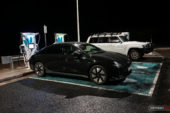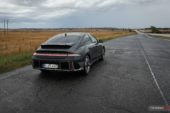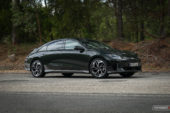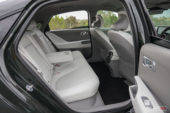No, it’s not a half-used bar of soap. This is the new Hyundai IONIQ 6, and it is Hyundai’s second all-electric model line following the retro IONIQ 5. Like soap, the 6 is extremely slippery, setting the record in aerodynamics for a mass-production Hyundai.
Is there more to the IONIQ 6 than slipperiness compared with the IONIQ 5? Well, to be honest, not really. It is a tiny bit quicker, mainly because it is slicker through the air, but it does include some technology updates and general evolution as well. It is the first Hyundai to offer over-the-air updates and the first electric Hyundai to feature its new Bluelink remote connectivity tech.
Three variants are on sale in Australia, including a base rear-wheel drive model called the Dynamiq, and two all-wheel drive versions called the Techniq and Epiq. All are based on the same E-GMP architecture as the 5, and indeed the Kia EV6 and Genesis GV60. The wheelbase is 50mm shorter in the 6 compared with the 5, giving you some idea of its sportier proportions.
2023 Hyundai IONIQ 6 – THE SPECS
Battery: 77.4kWh lithium-ion, 400V/800V
Output: RWD; 168kW/350Nm, AWD; 239kW/605Nm
Transmission: 1-speed auto
Drive type: RWD or AWD
0-100km/h (PD tested): 6.99 seconds (RWD), 4.91 seconds (AWD)
Tare weight: 1968-2078kg
Official range: 614km (RWD), 519km (AWD)
Starting price: $74,000
Prices start from $74,000, $83,500, and top out at $88,000 for each trim line. For comparison, the three-tier IONIQ 5 lineup spans from $72,000, $79,500, and $85,000 for the flagship. Given that SUVs are all the craze at the moment and the fact the 5 is similarly-packaged, we’re going to take a punt and say the 5 will lead the sales race between the two siblings. Especially with slightly lower price points (all exclude on-road costs).
As part of the official Australian media launch event press were given the opportunity to sample all three grades. We mostly drove the base RWD model and included it in our full performance test video further below. We also drove it from the event, which concluded in Victoria, up to home in Sydney to test out its grand touring capability.
An easy way to spot the all-wheel drive versions is by checking the wheels. They feature 20-inch mesh-style wheels while the base rear-wheel drive model features 18-inch aero wheels. These help provide an extremely low drag coefficient value of just 0.217. Going for the AWD versions also adds a set of Pirelli P Zero tyres which are superior to the RWD’s Hankook S1 Evo3 EV tyres (also comes with Nexen tyres, depending on what’s available during manufacturing).
In saying that, we notice the ride is smoother in the RWD model. With taller sidewalls, measuring 225/55 versus the low-profile 245/40 Pirellis, the RWD is likely to be more suitable for those favouring grand touring comfort and everyday drivability over sheer sportiness and handling precision. Speaking of which, the RWD model does feel quite vanilla down a set of twisty roads.
Steering feedback is almost numb but the platform seems to remain quite flat and focused on the job. We did notice a slight weight-shift delay as the mass catches up with your inputs, especially in sharper and higher-tempo scenarios. When driven in such a vigorous attitude, you can tip it as you trail off the brakes and the nose will dive, but then a split-second later there is often an after-shock wave as the weight shifts.
Most electric vehicles are heavy simply because of the stage of development we are currently at with batteries. Solid-state batteries could bring the mass down but production of such energy storage is likely to come with a higher environmental impact during manufacturing. Until they figure it all out, that is. So for now we just have to accept that EVs are heavy bastards. The IONIQ 6 RWD weighs in at 1968kg, with the AWD Techniq adding 110kg.
In terms of performance, Hyundai claims 0-100km/h in 7.4 seconds in the RWD Dynamiq and 5.1 seconds in the AWD models. However, using our Racelogic Vbox Sport we clocked some impressive numbers. On our usual private road we saw the RWD model record 0-100km/h in 6.99 seconds, and the quarter-mile in 15.17 seconds.
We didn’t get a chance to test the AWD configuration on the private road, but we did run three tests on a flat piece of deserted road in the middle of nowhere. It recorded a best of 4.91 seconds using the brake-hold method, and 5.07 seconds just by flooring it (all times recorded with traction control off). These are some quality numbers and it automatically means it should be a fun vehicle to drive for a wide variety of driver types.
As mentioned, we drove a RWD model from the launch event for a long interstate trip back home to see what it was like as a touring vehicle. Surprisingly, the drive wasn’t as frustrating or as anxious as we were expecting. The on-board range calculator was reasonably accurate but not perfectly trustworthy, and there were enough charging stations to keep us going. Including high-powered 350kW chargers.
Typical of the EV charging network, we did not see 350kW pour out from any charger. Instead, they always seem to be capped or throttled-down to around 130-150kW. Still, that level of power can provide a big charge in around 30 minutes. Our total trip was about 600km and we did two short charges using a 350kW public station. We could have charged up just the one time but we were planning to conduct the performance tests the next morning, so we prepped it ready to go.
When we set off the odometer was showing 1471km in total, with the range calculator showing 438km. Our first stop was 164km away, as indicated by the odometer that now read 1634km. However, the range calculator showed a distance of 243km. Obviously various factors influence the actual range, continuously, such as having the air-con on. But according to this small sample test the range calculator is out by 40km. It should have displayed 274km for the range, not 243km; 438km minus 164km is 274km.
Nonetheless, these calculations are based almost entirely on high-speed highway driving. This is not the ideal environment for an electric vehicle as they usually prefer urban conditions. Even so, the trip computer spat out an average energy consumption of 16.7kWh/100km. These figures might not mean much to you right now but figures in this format are set to replace the old L/100km standard. Based on previous EVs we’ve driven, anything under 18 is great.
We’re not a big fan of the design from square-on at the back, as it looks too tall and narrow in our opinion. But the rear diffuser sections looks pretty cool, and the curvy and flowing body lines help it stand out as something unique. The front end also incorporates rotating aerodynamic flaps that open and shut depending on what the vehicle requires.
Inside, this is a very calm and fuss-free interior. The floating centre console houses a large storage tray underneath, complete with rubber lining so things don’t slide all over the place. And then up top you’ll find the power window switches, leaving a thin and clutter-free door trim. Twin digital screens run across the dash, and, fortunately, there is a darkened night mode available so your eyes aren’t burnt to a crisp by the bright white light at night time.
Some of the materials in here are made from recycled products, such as floor mats made from old fish nets, and dash plastics derived from bio-ethanol created from sugarcane waste, which is all great. But, some areas feel a bit cheap in our opinion. This isn’t a cheap vehicle. The top of the front door trims and parts of the dash feel very tacky and shiny, like one of those Bunnings toilet seats that hangs on the end of an aisle, priced from $9.98 or something. We’d like to see some more thought go into these recycled materials. Surely they can be formed and manipulated to look and feel more lush?
Rear legroom is just massive. Which is a bit strange because headroom in the back isn’t. This is great for people with really long legs and a short torso. For everyone else, we’re afraid it’s off to the chiropractor for a neck alignment. Climate vents and twin USB-C charging ports are standard in the back, so top points there, and down below the seat is a vehicle-to-load charging port that supplies up to 250V/3.6kW/15A.
The boot opening is quite small but with 446 litres available, the volume isn’t too bad. There’s also some under-floor storage. And of course, being an electric vehicle, there is no engine under the bonnet. Instead, the RWD model offers 45 litres of additional space. Going for the all-wheel drive configuration sees that drop to 15 litres due to the front-mounted e-motor.
2023 Hyundai IONIQ 6 – THE VIDEO
On first impressions, what do we think of the new IONIQ 6? It is just like the IONIQ 5 but a bit sportier, with a lower centre of gravity and all of that. But in essence it is mostly the same. Practicality is reduced and it is more expensive. Perhaps critically, it is not an SUV, which is what we all seem to want these days – or a ute.
In saying that, the IONIQ 6’s nearest competitor, the Tesla Model 3, is extremely popular at the moment so this should theoretically attract similar numbers. Unlike the 3, though, the IONIQ 6 is designed and developed by a car manufacturer that has extensive experience in the industry.










































